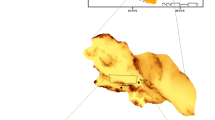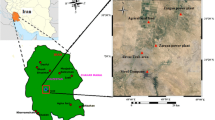Abstract
This study assessed the effect on magnetic susceptibility and organic matter content of arable soil by irrigation with either treated sewage or groundwater. Results indicated that organic matter and magnetic susceptibility values in the soil irrigated with sewage were increased by 7.1 % and 13.5 %, respectively, compared to agricultural soil that irrigated with groundwater. Both the sewage and groundwater irrigated soils contained a significant fraction of ultrafine superpara magnetic grains, as indicated by high frequency dependent susceptibility (χfd > 6 %). The enhancement of soil magnetic properties was determined to be caused by anthropogenic sewage irrigation and agrochemical use by investigation of vertical soil profiles. Magnetic susceptibility parameters were shown to be significantly correlated with organic matter content (y = 0.0057x + 1.3439, R2 = 0.09, p < 0.05). This work indicates that measurements of magnetic susceptibility may offer a rapid first step for identifying the potential pollution in arable soils.



Similar content being viewed by others
References
Blaha U, Appel E, Stanjek H (2008) Determination of anthropogenic boundary depth in industrially polluted soil and semi-quantification of heavy metal loads using magnetic susceptibility. Environ Pollut 156:178–289
Blundell A, Dearing JA, Boyle JF, Hannam JA (2009) Controlling factors for the spatial variability of soil magnetic susceptibility across England and Wales. Earth Sci Rev 95:158–188
Dearing JA, Dann RJ, Hay K, Lees JA, Loveland PJ, Maher BA, Ogrady K (1996) Frequency-dependent susceptibility measurements of environmental materials. Geophys J Int 124:228–240
Evans ME, Heller F (2003) Environmental magnetism: principles and applications of enviromagnetics. Academic Press, San Diego, CA, pp 21–25
Friedel JK, Langer T, Siebe C, Stahr K (2000) Effects of long-term waste water irrigation on soil organic matter, soil microbial biomass and its activities in central Mexico. Biol Fertil Soils 31:414–421
Grimley DA, Vepraskas MJ (2000) Magnetic susceptibility for use in delineating hydric soils. Soil Sci Soc Am J 64:2174–2180
Hana F, Günter M, Eduard P (2005) Magnetic properties of soils from sites with different geological and environmental settings. J Appl Geophys 59:273–283
Hanesch M, Scholger R (2005) The influence of soil type on the magnetic susceptibility measured throughout soil profiles. Geophys J Int 161:50–60
Hu XF, Su Y, Ye R, Li XQ, Zhang GL (2007) Magnetic properties of the urban soils in Shanghai and their environmental implications. Catena 70:428–436
Jordanova D, Jordanova N (1999) Magnetic characteristics of different soil types from Bulgaria. Stud Geophys Geod 43:303–318
Lecoanet H, Léveque F, Ambrosi JP (2003) Combination of magnetic parameters: an efficient way to discriminate soil-contamination sources (south France). Environ Pollut 122:229–234
Magiera T, Jankowski M, Switoniak M, Rachwal M (2011) Study of forest soils on an area of magnetic and geochemical anomaly in north-eastern Poland. Geoderma 160:559–568
Maher BA (1988) Magnetic properties of modern soils and Quaternary loessic paleosols: paleoclimatic implications. Paleogeogr Paleoclimatol Paleoecol 137:25–54
Maier G, Scholger R (2004) Demonstration of connection between pollutant dispersal and atmospheric boundary layers by use of magnetic susceptibility mapping St. Jacob (Austria). Phys Chem Earth A 29:997–1009
Mullins CE (1977) Magnetic susceptibility of the soil and its significance in soil science—a review. J Soil Sci 28:223–246
Nelson DW, Sommers LE (1982) Total carbon, organic carbon, and organic matter. In: Page AL, Miller RH, Keeney DR (eds) Methods of soil analysis. Part 2. Chemical and microbiological properties. ASA-SSSA, Madison, pp 539–594
Neumeister H, Peschel G (1968) Magnetic susceptibility of soils and Pleistocene sediments in the neighbourhood of Leipzig. Albrecht Thaer Archiv 12:1055–1072
Petrovsky E, Kapicka A, Jordanova D, Knab M, Hoffmann V (2000) Low-field magnetic susceptibility: a proxy method of estimating increased pollution of different environmental systems. Environ Geol 39:3–4
Rattan RK, Datta SP, Chhonkar PK, Suribabu K, Singh AK (2005) Long-term impact of irrigation with sewage effluents on heavy metal content in soils, crops and groundwater—a case study. Agric Ecosyst Environ 109:310–322
Shilton VF, Booth CA, Smith JP (2005) Magnetic properties of urban street dust and their relationship with organic matter content in the west Midlands, UK. Atmos Environ 39:3651–3659
Thompson R, Bioemendal J, Dearing JA (1980) Environmental applications of magnetic measurements. Science 207:481–486
Torrent J, Liu QS, Barron V (2010) Magnetic susceptibility changes in relation to pedogenesis in a Xeralf chronosequence in northwestern Spain. Eur J Soil Sci 61(2):161–173
Xie S, John A, Dearing JA (2000) The organic matter content of street dust in Liverpool, UK, and its association with dust magnetic properties. Atmos Environ 34:269–275
Yadav RK, Goyal B, Sharma RK, Dubey SK, Minhas PS (2002) Post-irrigation impact of domestic sewage effluent on composition of soils, crops and ground water—a case study. Environ Int 28:481–486
Yang PG, Mao RZ, Shao HB (2009) An investigation on magnetic susceptibility of hazardous saline-alkaline soils from the contaminated Hai River basin, China. J Hazard Mater 172:494–497
Yang PG, Yang M, Shao HB (2012) Magnetic susceptibility and heavy metals distribution from risk-cultivated soil around the iron-steel plant, China. Clean-Soil, Air, Water 40(6):615–618
Yildirim M, Topkaya B (2012) Assessing environmental impacts of wastewater treatment alternatives for small-scale communities. Clean-Soil, Air, Water 40(2):171–178
Zhang CX, Appel E, Qiao QQ (2013) Heavy metal pollution in farmland irrigated with river water near a steel plant—magnetic and geochemical signature. Geophys J Int 192:963–974
Acknowledgments
The authors are grateful to the editor Erin Bennett, anonymous reviewers for their useful suggestions and Pro. Erwin Appel for constructive discussions. This work was supported by the National Natural Science Foundation of China (NSFC No.31272258).
Author information
Authors and Affiliations
Corresponding author
Rights and permissions
About this article
Cite this article
Yang, P.G., Yang, M., Mao, R.Z. et al. Impact of Long-Term Irrigation with Treated Sewage on Soil Magnetic Susceptibility and Organic Matter Content in North China. Bull Environ Contam Toxicol 95, 102–107 (2015). https://doi.org/10.1007/s00128-015-1562-0
Received:
Accepted:
Published:
Issue Date:
DOI: https://doi.org/10.1007/s00128-015-1562-0




